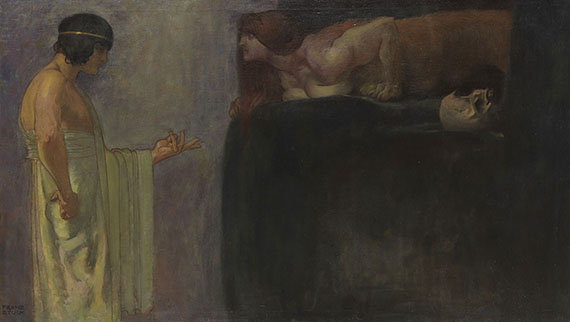Dictionary


Italian Symbolism
The center of the Italian symbolist movement was the industrialized North around the metropolis of Milan. The Italian concept of Symbolism was clearly influenced by France. The work of Gaetano Previati (1852-1920), for instance, shows the reception of French Symbolism, which finds expression in a somewhat mannered mysticism. However, a certain influence of Futurism and post-impressionist Divisionism cannot be denied.
The most famous Italian symbolist was Giovanni Segantini (1858-99). Born in Arco on Lake Garda, he makes Switzerland his home, where he lived to paint his preferred high mountain landscapes. In terms of style, he had developed his very own variant of Pointillism and decomposed the colors into lines arranged side by side, in order to express the unbroken mountain light. Segantini found great inspiration in the peasant pictures of Jean-François Millet, whose concept of the depiction of man and nature was one of an interdependence. In his geometric landscapes, the horizontal represents nature, onto which the vertical human bends down. Segantini addresses existential issues regarding life, death and religion in his landscapes and allegories.
The literary direction of Symbolism in Italy is represented by the illustrator Alberto Martini (1876-1954), who had an interest in the dark and gloomy, in dreams, in death and disease, which was typical for these days. Like other artists who were in a similar mindset, such as Max Klinger or Alfred Kubin, he had studied old German prints of the 16th century. A prime topic is the connection between death and women. His illustrations for narratives by Edgar Allan Poe are especially impressive and modern, the chiaroscuro within the strongly simplified composition effectively expresses the texts' terrifying contents.
Other artists, which count at least partly among Italian symbolists, are Vittorio Zechinni, Romolo Romani and Guido Cadorin.
The center of the Italian symbolist movement was the industrialized North around the metropolis of Milan. The Italian concept of Symbolism was clearly influenced by France. The work of Gaetano Previati (1852-1920), for instance, shows the reception of French Symbolism, which finds expression in a somewhat mannered mysticism. However, a certain influence of Futurism and post-impressionist Divisionism cannot be denied.
The most famous Italian symbolist was Giovanni Segantini (1858-99). Born in Arco on Lake Garda, he makes Switzerland his home, where he lived to paint his preferred high mountain landscapes. In terms of style, he had developed his very own variant of Pointillism and decomposed the colors into lines arranged side by side, in order to express the unbroken mountain light. Segantini found great inspiration in the peasant pictures of Jean-François Millet, whose concept of the depiction of man and nature was one of an interdependence. In his geometric landscapes, the horizontal represents nature, onto which the vertical human bends down. Segantini addresses existential issues regarding life, death and religion in his landscapes and allegories.
The literary direction of Symbolism in Italy is represented by the illustrator Alberto Martini (1876-1954), who had an interest in the dark and gloomy, in dreams, in death and disease, which was typical for these days. Like other artists who were in a similar mindset, such as Max Klinger or Alfred Kubin, he had studied old German prints of the 16th century. A prime topic is the connection between death and women. His illustrations for narratives by Edgar Allan Poe are especially impressive and modern, the chiaroscuro within the strongly simplified composition effectively expresses the texts' terrifying contents.
Other artists, which count at least partly among Italian symbolists, are Vittorio Zechinni, Romolo Romani and Guido Cadorin.
Offers
Headquarters
Joseph-Wild-Str. 18
81829 Munich
Phone: +49 89 55 244-0
Fax: +49 89 55 244-177
info@kettererkunst.de
Louisa von Saucken / Undine Schleifer
Holstenwall 5
20355 Hamburg
Phone: +49 40 37 49 61-0
Fax: +49 40 37 49 61-66
infohamburg@kettererkunst.de
Dr. Simone Wiechers / Nane Schlage
Fasanenstr. 70
10719 Berlin
Phone: +49 30 88 67 53-63
Fax: +49 30 88 67 56-43
infoberlin@kettererkunst.de
Cordula Lichtenberg
Gertrudenstraße 24-28
50667 Cologne
Phone: +49 221 510 908-15
infokoeln@kettererkunst.de
Hessen
Rhineland-Palatinate
Miriam Heß
Phone: +49 62 21 58 80-038
Fax: +49 62 21 58 80-595
infoheidelberg@kettererkunst.de
We will inform you in time.




